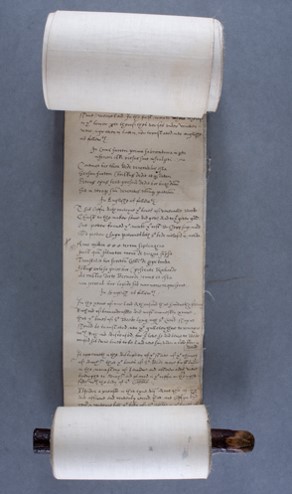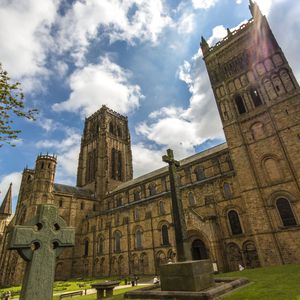Today, 15 June, is the Feast of Corpus Christi. This feast, traditionally celebrating the ‘Body of Christ’ represented by the bread and wine of the sacrament of Communion, has been a highlight of the Christian calendar for nearly 700 years, and is still the premier feast day following the celebration of Easter. Special services will be held in churches and cathedrals around the world today, including a service in Durham Cathedral at 7:30 this evening. But how was Corpus Christi celebrated in medieval Durham?
We get an apparent first-hand account in a recusant work called The Rites of Durham, probably written by one William Claxton, writing about his memories of

The earliest manuscript of The Rites of Durham, c. 1593 (the ‘Hogg Roll’, DCL MS C.III.23, courtesy of Durham Cathedral Library)
Durham Priory in the decades after the dissolution of the monastaries in 1536. In a section entitled ‘The ancient solemnity of procession upon Corpus Christi Day’, the text of the Rites relates the events of the day as follows:
(LVI.) The Auntient solemnytie of p<ro>cession vpō corpus christi day wthin ye church and citie of durham before ye suppressiō of ye said abbey Church.
There was a goodly p<ro>ssessiō vpō ye place grene on ye Thursday after Trinitie sonndaie in ye hono’ of corp<us> Christi daie ye wch was a pryncipall feast at that tyme. The baley of the towne [did stand in ye towle bowth[i] and did calle ye occupac’ons that was inhabiters wth in ye towne eu’y occupatiō in his degre to bring forthe ther Ban’ wth all the lightes app<er>teyninge to there seu’all Bann’<es> & to repaire to ye abbey church Doure eu’y banner to stand a Rowe [in ranke, Cos.] in his Degree from ye abbey church Dour to Wyndshole yett,[ii] on ye west syde of ye waye did all ye Bann’<es> stand, and on ye easte syde of ye way dyd all ye Torges [torches, Cos.] stand p<er>teyninge to ye sayd Bannares.
[There was a goodly procession upon Palace Green on the Thursday after Trinity Sunday in honour of Corpus Christi day, which was the principal feast at that time. The bailiff of the town stood in the toll booth and called upon the occupations (trade ‘guilds’) that inhabited the town, every occupation in his rank to bring forth their banner with all the lights/torches pertaining to their several banners and to journey to the abbey church door, every banner to stand in a row according to degree/rank, from the abbey church door to ‘Windy Gap’. On the west side of the way all of the banners stood, and on the east side of the way all of the torches stood, pertaining to the said banners.]
Also there was a goodly shrine in Sacte Nicholas church, ordeyned to be caryed ye sayd daie in Prossession cauled
Corpus Christi shrine all fynlye gilted a goodly thing to behould, and on ye hight of ye sayd shrine was a foure Squared Box all of cristall, wherin was enclosed the holy sacramt of thaulter and was caryed ye said daie with iiij preistes vp to ye place grene & all ye hole prossessiō of all ye churches in ye said towne goyng before ytt and when it was a litle space wthin Wyndshole yett yt dyd stand still, then was Sacte Cuthb: Bann’ browghte fourth wth two goodly faire crosses to meete yt and ye p’or & covent wth all ye whole companye of ye Quere all in there best copes dyd meet ye said shrine sytting on there kneys[iii] and prayinge. The prior did sence yt[iv] [fetch it, Cos.] and then caryinge yt forward into the abbey church ye p’or and covent wth all the quere following yt. It was sett in ye quere & solemne s’vice don before ytt and Te Deum solemnly songe and plaide of ye orgayns eu’y mā praysinge god and all ye Bann’<es> of ye occupac’ons[v] dyd followe ye said shrine into ye church goyng Rownde about Saincte Cuthb: fereture lyghtinge there Torches & burning all ye s’vice tyme. then yt was caryed frome thence wth ye said p<ro>ssessiō of ye towne back againe to ye place from whence it came & all the Ban’<es> of ye occupac’ons following it, & setting yt againe in ye church, eu’y mā maiking his prayers to god did dep<ar>te, and ye said shrine was caryed into ye Revestrie where yt Remayned vntill that tyme Twelvemonthe.
[There was a goodly shrine in St. Nicholas’s church, which was ordained to be carried on the said day in procession, called the Corpus Christi shrine, a finely gilded, a beautiful thing to behold. And on the top of the said shrine was a four-square box of crystal, wherein the holy sacrament of the alter was enclosed. And [it] was carried on the said

Durham City map by John Speed, 1610 (DUL MS Gibby City/B/37); showing the location of St. Nicholas’s church (above) and Durham Cathedral (below); map image courtesy of Durham University Library.
day by 4 priests up to Palace Green, and all the whole procession of all the churches in the said town going before it. And when it [the procession] was near to ‘Windy Gap’ it paused. Then Saint Cuthbert’s banner was brought forth with two fine crosses to meet it. And the Prior and convent with all the company of the choir in all their best copes met the said shrine, sitting on their knees (kneeling) and praying. The Prior censed it; it was set in the quire, and solemn service was done before it, and Te Deum solemnly sung and played on the organs, every man praising God. And all of the banners of the occupations followed the said shrine into the church, going round about St. Cuthbert’s feretory (shrine), lighting their torches and burning the length of the service. Then it was carried from thence with the said procession of the town going back again to the place from whence it came, and all of the banners of the occupations following it, and setting it again in the church, every man, making his prayers to God, departed. And the said shrine was carried into the revestry where it remained until the same time a year later.]
[i] the towle bowth]. Bishop Tunstall built a Toll booth “of eslier worke” (ashlar) in the Market Place, and the suffragan bishop Sparke set up a cross, also in the Market Place, where the old Toll booth had stood, namely, near the middle of the “square.” – Scr. Tres, 155, 156; Raine, Auckland, 64n.; Hutchinson, Durham, II, 295.
[ii] Wyndshole yett]. There was probably a gate at the top of the lane or path that leads down from the S.W. corner of the Green to the Banks, now called “Windy Gap.”
[iii] sytting on there kneys]. Kneeling.
[vi] The prior did sence yt]. He censed it, of course. The absurd reading “fetch” is in all the editions as well as in Cosin’s MS.
[v] ye Banners of ye occupac’ons]. Those of the various trade guilds.
This month’s flower has been provided by REED: Durham co-editor Mark Chambers, with assistance and notation by fellow editor John McKinnell.
To learn more about Corpus Christi in Durham – including evidence about the plays that would have been performed by Durham’s medieval trade guilds – listen to the podcast of Dr Mark Chambers’s talk in Durham Cathedral last year: https://reed-ne.webspace.durham.ac.uk/?page_id=2211


